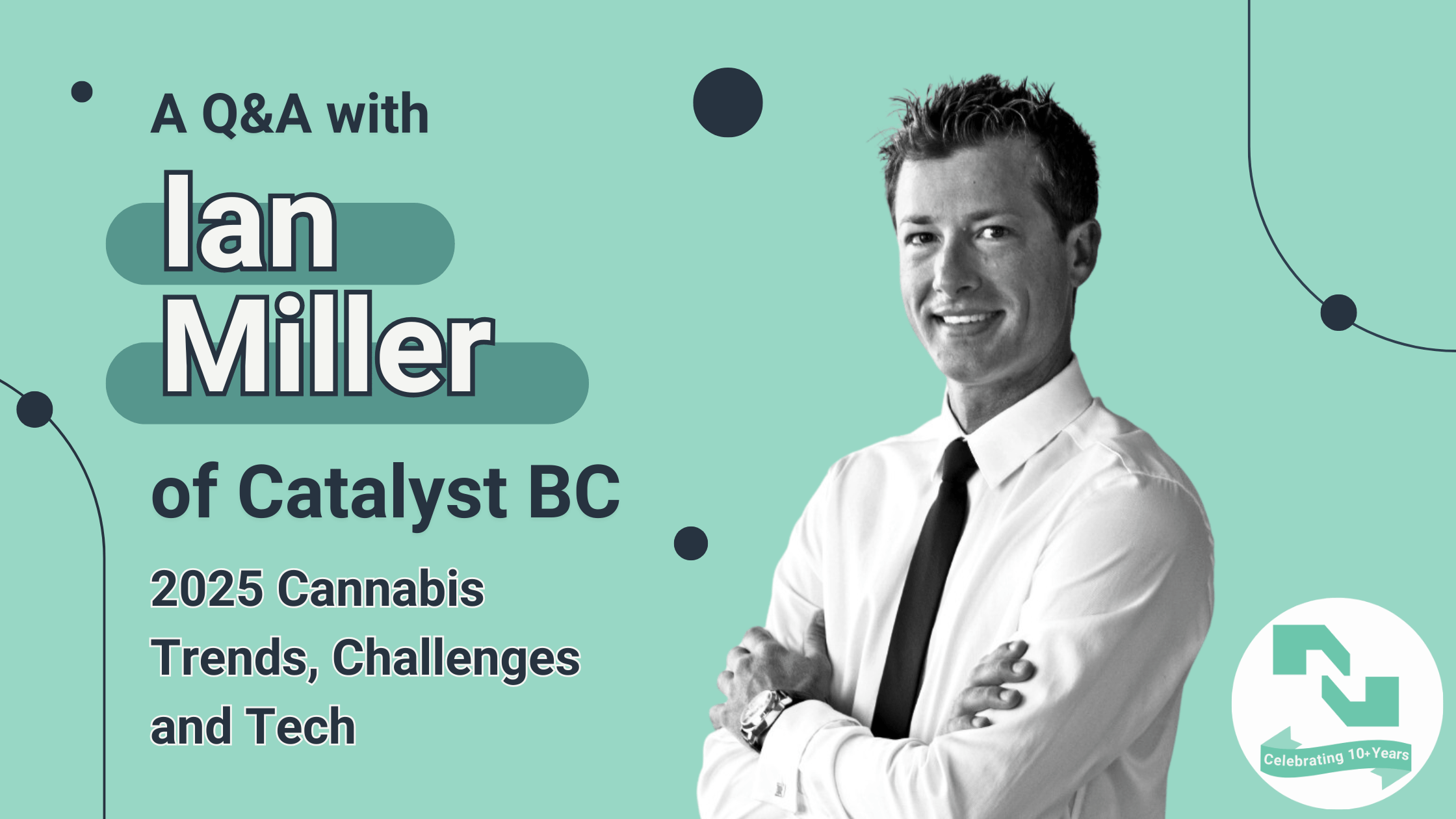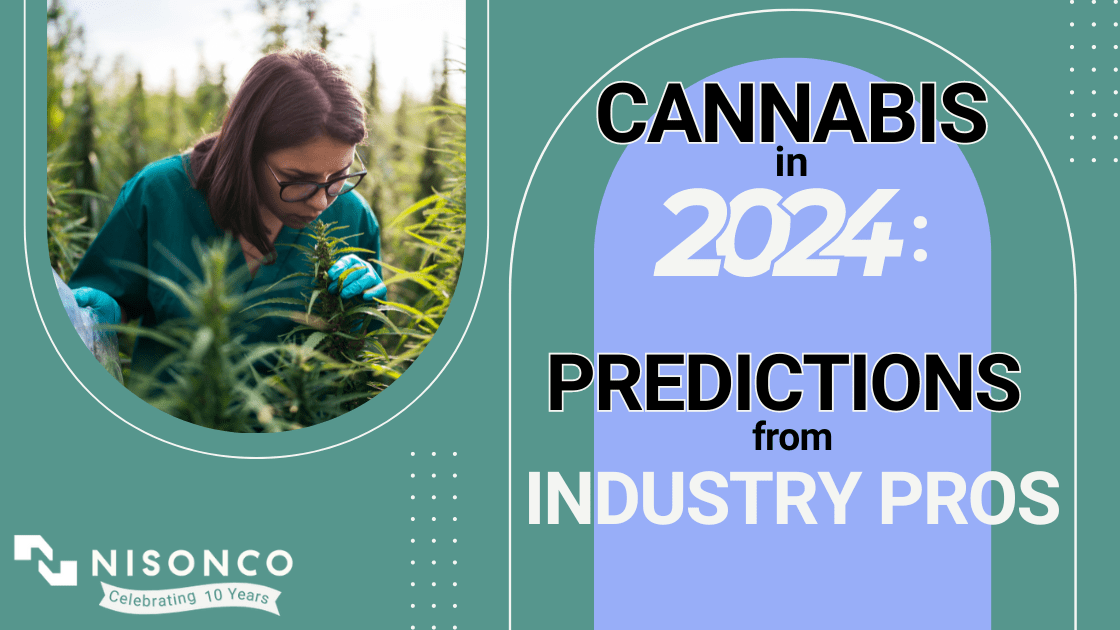Ian Miller, CEO of Catalyst BC, is passionate about using his team’s experience and his company’s comprehensive consulting services to help cannabis companies maximize their resources and achieve their operational and financial goals. Specifically, Catalyst provides its clients with license application and acquisition, facility design, engineering, procurement, and specification support, commissioning, all-stages operational support, pre-exit optimization, turnaround services, and more.
This last year at MJBizCon, NisonCo Content Director Marissa Black-Smith met with Ian to discuss his thoughts on cannabis trends and his predictions for the sector in 2025.
Marissa Black-Smith: How has 2024 been?
Ian Miller: Across the board, it’s been up and down. Recently, maybe in the last three months, we’ve seen a lot of renewed investment activity and interest in the space. I don’t know if that’s a political thing, a capital thing, or if it’s just the change in interest rates that has people moving, but business is looking up, and it seems to be for most other people as well.
Are there any 2024 market trends you saw and want to shout out?
Ian: I mean, gummies are banging. “Purple Candy Gas” is banging. Let’s see. I think we’re getting the sense that the reckless money that’s come into the space to a certain extent has shaken itself out.
Unfortunately, we’ve seen some big celebrity brands pop up and evaporate. I think “what’s inside the pretty package” and “authenticity” are starting to matter again. That could be because of the overhype of non-authentic players in the market. Authenticity seems to have a real hold in the marketplace and has staying power — thank goodness.
Marissa: Can the authenticity you’re discussing coexist with industry-wide conglomerations, or are they fundamentally at odds?
Ian: You know, I think the folks in the conglomerates, the MSOs, the public companies, and so on — they would like to believe that there’s the possibility of authenticity at the scale where you’re hiring big-name marketing companies and that kind of stuff. I’m not really sure if they’re necessarily compatible in this industry. We’ve seen [alcohol companies], for example, try to sort of inject themselves into the craft space. There’s just something that gets lost, and I think the cannabis consumer of today recognizes that the authenticity is either actually there or it’s not. Some consumers and patients care about that and some do not.
As the cannabis industry pursues profits to become the best business-based industry possible, how does it stay true to its social equity roots and heritage?
Ian: I mean, the good news is that all of the OGs in the space are interested in flavor, quality, progression of flavor, and the experience of consuming the herb. That ultimately ends up being what consumers lean into anyway. You’re obviously going to have your distillate gummy consumer who may not appreciate some of those nuances, but because cannabis is a lot like wine in terms of having really divergent qualities that appeal to some people, don’t appeal to others — and the fact that we have all these variations in cultivars that all of these incredible breeders have put out — I think there’s the opportunity for people to find the flavors that work for them and embrace what they love.
Now, to get back to the actual question — how do we pursue profitability? Honestly, I would say there’s definitely a place for “Walmart weed” in this industry. Some people just want to melt their face off for the cheapest they can possibly pay. But there is a heck of a lot of room for people leading the space in differentiation, whether that’s flavor, experience, terroir, or some combination that might matter to consumers. I mean, gosh, even differentiators like gluten-free and sugar-free — there’s a lot of room for innovations like that.
Quality innovations are where a lot of the profit comes from if done properly. This is a selfish plug for Catalyst BC because we help people spend as little as they need to realize their mission — we’re also there to help get them the outsized yields and the outsized profits that they’re looking for. Ultimately, management of yield at the garden level is where most of the profits in the industry are going to derive from because that sort of foundational layer of the supply chain is where a lot of optimization needs to happen.
So, for any of the folks that, for example, cannot pay their bills or have investor infighting issues that are revenue-based, margin-based, or profit-based, almost all [issues] come from not getting the yields they anticipated they would get from their gardens. That can be bad planning, bad investments, bad genetics, bad SOPs, or bad work instructions, but like when someone says to me, “How do I make more money in the space? How do I realize more profit in the space?” It all starts in the garden.
Are you anticipating any major market movements in 2025, whether related to regulation, M&A activities, or anything else?
Ian: Oh man, I wish I had that Magic 8 Ball. That would make me influential indeed. What do I think is going to happen? I think EU-GMP exportation will be a big, big topic for everybody. I think that gives all the OGs and heads an opportunity to get their great genetics out there.
The European Union is difficult because of product authorization, shelf stability testing, and everything else that goes with it. It’s going to change the game a little bit or a lot — maybe not for the better for Europe-based consumers, unfortunately.
What else? I would like to see more private equity in the space. I would like to see more local credit unions get together at the board level and say, “This is normalized enough. We want to put out money at 7%, 8%, 9% instead of people having to go to the big guys out there at 17% to 24%.” Those are really the things I would like to see. That would help many new operators, particularly smaller ones, get their feet underneath them without the undue pressure of paying untenable amounts of interest. But whether that’s going to happen or not, at this point, kind of depends a little bit on the federal government.
We hope the new administration will at least support the direction things are going right now, if not advance that pace. If they advance the pace, things will go really well quickly.
What innovations or tools, such as AI or automation, are capturing your attention lately?
Ian: The continued advancement of LEDs as a photonic platform is definitely changing the game. You can meet new energy codes. You can have [a smaller] thermal control portion of HVAC. That’s bringing down investment costs if you plan your project right.
Some really interesting AI platforms are starting to come to market that can optically identify oncoming symptoms of what could be crop problems, potential crop failure, and those kinds of things. Those are really interesting technologies with a lot of room to change things for people. SpexAI is one of the ones leading this charge.
Unfortunately, they will end up making operations more lean from a personnel standpoint. I tend to sort of have weird feelings about technologies that make for fewer jobs because that was one of the factors that we really advertised legal cannabis under, like, “Hey, we’re going to bring a lot of jobs.” Really, the tech will allow people to run with as few personnel as they can possibly get away with and from a jobs perspective, that sucks. From a profitability perspective, maybe it’s great. That’s always one of those trade-offs.
In the multispectral and hyperspectral imaging range of things, if someone figures out how to identify particular nutrient deficiencies, that would be a cool piece of tech for somebody to bring to the table. I think it’s possible. I think there’s a lot of OG knowledge in terms of little changes in the appearance of a plant that signal things we’re not really measuring right now with the instruments in play. In that vein, the proliferation of good data gathering, reliable sensors, and quality analytics platforms will make all that data make sense and be actionable. Those are probably interesting advancements we need to see.
Are there any international markets that you’re particularly excited about right now?
Ian: I mean, honestly, we’re cautiously excited about Germany for obvious reasons. I have always regarded Germany from a cannabis perspective as a potential sales target that probably isn’t very much of a potential sales target over the long run. The way I’ve explained it before is if I’m the chancellor of Germany. I’m watching my industry pay, you know, two, three, four thousand dollars a pound to import an agricultural product from another country — and my country builds some of the best mechanical automation and industrial systems literally on this planet of Earth — am I going to sit around and say, “Yeah, that’s a great idea. Let’s just keep sending our money outside of the country.” I don’t think it’s a sustainable model.
From our perspective as advisors who help people spend their money right, optimize their operations, run lean, and run profitably, it’s a great opportunity. Still, it has to hit a certain scale for it to be worth it for us.
We’re definitely excited about Sri Lanka. Their industry is going to be incredible. For many years, Sri Lanka was the number-one source of the finest teas on the planet. They have six different microclimate zones in the same country, all within very short distance of each other. So, the ability to integrate concepts like organic growing, terroir, regional cultivation, and stuff like that is [exciting] there and in certain areas in South America, as well.
I’d love to see Mexico get going. I think Costa Rica is going to be interesting, and the Virgin Islands could be a really interesting micro-market.
And then, honestly, we need to think, “What does it look like to be in India? What does it look like if Indonesia were to change their laws? What if Japan were to start accepting a sort of Ayurveda-type concept or something else?” A lot of the world still illegally consumes cannabis, and so I think there’s nothing but an exciting blue ocean [of opportunity] out there if you play your cards right.
Marissa: Absolutely. Hearkening back to COVID, we obviously experienced a lot of bottlenecks, supply chain issues, and bumps in the road.
Are you anticipating any shortages or potential bottlenecks in 2025 that people should be aware of when planning?
Ian: Access to AI, I think, is going to be something really interesting. We’re seeing extremely advanced AI models come to market very rapidly. But let’s face it: the people who put them together didn’t get billions of dollars of investment to make an experiment out of them, so they’ll be paywalled at some point.
The microchip shortage we had with trucks and cars may very well be something that comes up in the future. The Trump administration is basically inviting a tit-for-tat trade war with China and potentially some of the areas in China’s sphere of influence. All it takes is a little bit of, “We’re going to categorize this technology or these specifications of chips as national security assets,” and the flow out of China stops instantaneously. That impacts a lot. [If that were to happen,] I couldn’t build my product anymore because of that non-availability. It could mean a year’s worth of redevelopment, chip, board, programming, and all the troubleshooting and development that goes into creating a product. So, there could be mass disruptions in that vein.
Those are the things I’m concerned about. Access to the progression of quality data and analytics is a really big one because that’s where a lot of our growth and profit growth is going to come from: Access to integrated systems that require processing power and chips. I think those are sort of weird dangers to be talking about in the weed industry, but here we are. We’ve advanced a lot, right? Those things matter all of a sudden.
What types of cannabis businesses do you think are going to continue to be the most attractive to investors in the years to come?
Ian: Today’s investor, and probably the last five years, is really interested in existing cash-flowing businesses. The folks who bootstrap in the beginning will do really well if they can take themselves from bootstrap mode into sophisticated operating mode. And that admittedly can be quite challenging.
Folks who are deploying smart money without lots of strings attached to it, regardless of what space of the business they’re in, who can take that smart money, actuate on it, and use a combination of good capital, good intentions, good skills, and good people to build resilient, nimble businesses. I think they’re going to have a real advantage because if I can show someone that I built a business with an absurd return on capital in the beginning [if I bootstrapped], the numbers that I’m putting down in terms of free cash flow, margins, EBITDA, things like that are really strong. I think they’re in a prime position to be the next people at the pitching table, getting that next big tranche of investment money to go and do their thing.
Marissa: It’s not necessarily a type of business; it’s more of a way of running your business.
Ian: Yeah, I think it’s more the way of running the business.
Suppose the Trump administration continues along the line that the Biden administration started in terms of more formally normalizing things. In that case, I think all of a sudden, people who have really heavily invested blood, sweat, tears, and lots of cash in retail infrastructure are in for a really nice surprise and a really nice windfall as long as they can comply with whatever new regs come down the line, and as long as the Fed isn’t overly heavy-handed in terms of taxation and excise issues. I think they’re good.
Honestly, the small, nimble craft scale operators that have made themselves sophisticated enough to survive in a more heavily regulated environment and with choosier customers [are attractive to investors]. They are also almost in a completely diametric position to some of those other folks. They’re in an excellent position to survive because they have true brand equity. People love what they make. They’ve conquered their own backyard. They’re not spending too much on marketing. They’re not paying cost per acquisition for customers; Customers come because they’ve heard that their product is great. There’s real magic to that almost “guerrilla craft,” I would call it, where you’ve really built sound brand equity within your customer base. Those companies are going to do really well.
And then ancillaries: If you’re well positioned in ancillary industries and have a true competitive advantage that can’t be gobbled up by an upstart foreign company that eats you for lunch, [you’re] also in really good shape.
As usual, the innovators and the people who know how to wield innovation from an advisory level and an ops level are really primed for growth, as well.
Any other general predictions you want to throw out there for 2025?
Ian: I think we’re going to hear a lot of people talking about four pounds per light. Yield efficiency is going to be a big topic. Whether people can actually deliver it or not in their operations [remains to be seen], it was three pounds per light a couple of years ago, and I think four pounds per light is going to be the big thing now.
I believe we’ll see some 38 to 42% THC tests coming through. You know, the guys who do the breeding and the guys who do all of the intricate agronomics are working hard to push the envelope. And God bless them because that’s what drives everything forward.
Marissa: Yes. Our favorite mad scientist growers.
Ian: Yep. We love them.
Marissa: Any plugs for Catalyst BC?
Ian: Absolutely. If you’re an entrepreneur or operator, a CFO, a lender or an investor in the space and you want to make sure you and/or your investment are planning for or obtaining the best juice out of your squeeze – exceptional yields (in the 80-120 grams per square foot range), margins, customer retention, profits, net enterprise value on exit, or if you’re having struggles meeting financial or operational goals at cultivation, CPG, or retail levels, give us a call – we’re literally free to most clients because of the value we create for them quickly and over time and an initial phone consult is always gratis.
Thank you so much, Ian, for your time and insights! One of the best things about attending cannabis conferences is getting to connect with other professionals who are as passionate about the cannabis industry as we are.
You can connect with Ian on LinkedIn and find out more about his company, Catalyst BC, on their website or LinkedIn.



